Interactive Media Technology Center History
The Interactive Media Technology Center (IMTC), now absorbed into IPaT, was a research, design, and education center dedicated to research spanning technology, education, culture, and medicine. IMTC’s focus was in digital media processing, and they applied their research to a wide variety of areas including culture, education, and technology. IMTC played a pivotal role in helping the city of Atlanta win the 1996 Olympic Games. Note that several links on this timeline open a new window to get additional information.

1987
Originally formed as the Multimedia Technology Lab (MmTL) under the Office of Interdisciplinary Programs (OIP) with co-directors Michael Sinclair and Fred Dyer. The initial project was to create a virtual reality system supporting Atlanta's bid for the 1996 Olympics.
More info
OIP executive administrator Jean Gunter provided key support. The lab was located in Centennial Research Building, 3rd floor.
1987 - Bidding for the Olympic Games Starts
The centerpiece of Atlanta's 1996 Summer Olympic bid package was a seven-foot-tall, three-screen interactive video-disc system equipped with touch screen and trackball controls. View picture of the screens. The system was developed by Georgia Tech and GTRI researchers, with assistance from other universities and off-campus organizations. Three interactive presentations were produced by IMTC.
More info
The multimedia presentation combined virtual reality techniques, computer graphics, animation, and aerial photography that allowed viewers to take a virtual airborne tour of proposed Olympic venues. The roots of the Olympic interactive video system could be traced to earlier military projects, including missile defense modeling and simulation research.
August 27, 1989
Olympic System 1 - Magic Carpet Ride
IMTC's first project was to develop an interactive tour of Atlanta and its planned Olympic venues. It allowed International Olympic Committee (IOC) members to fly around the city from the comfort of a hotel suite using a graphics computer and a wooden encased trackball.
More info
The system was unveiled at Atlanta's official entry into the Olympic bid race in San Juan, Puerto Rico, in September, 1989. A map screen showed where the user was in the city, and icons for each Olympic sport. The user could "fly" into icons representing the sports venues, and the video screen would descend to earth and enter the facility. The system served as a "virtual" bid book, as each voting member could easily and quickly, and interactively look up information pertinent to their questions. The system spent the year after its premier traveling the world to wherever voting IOC delegates met to help sell Atlanta to the world.
1990

Olympic System 2 - Vision of the Village
Tech's second Olympic system took an up close and personal look at plans for Atlanta's Olympics. Many of the facilities, such as the Olympic Village, were shown in a high-tech theater using a surround interactive video system developed by Tech.
More info
IMTC and the Atlanta Organizing Committee decided that Atlanta needed another high-tech sales tool for the final vote for the Centennial games, scheduled for Tokyo, in September, 1990. The system was unveiled in the final days of the Olympic bidding in Tokyo in 1990. Both Olympic systems were a collaboration of a number of campus and industrial collaborators.
1990-1996
Olympic System 3 - Vision of Atlanta
The final version of the system was upgraded to contain information on all of Georgia's Olympic sites and widely shown for many years. This system presented panoramic views of Atlanta and the state of Georgia, with an opportunity to move through panoramas and select venues for more information. This system became part of the Georgia Resource Center, an economic development facility for Georgia.
More info
This iteration of the system featured an animated map of the Georgia Tech campus back-projected onto a frosted Lucite model. This served as a sort of touch screen controller. Touching points on the Lucite map would drive the location viewed on the screens. This huge feat wasn’t accomplished in a silo. Team members' recall how willing businesses and organizations were to pitch in. For example, Delta Airline’s machine shop assisted with the Lucite model. People from Georgia State wrote the scripts and managed production of video for the final presentation that was delivered to the International Olympic Committee in Tokyo in 1990. One example in this version was the full-color computer-simulated "fly-through" of the Olympic whitewater events venue. It was designed to orient TV viewers whenever Olympics coverage shifted from Atlanta-area sports venues to the whitewater course in Tennessee. GTRI developers integrated data from the LANDSAT satellite, high-altitude and low-altitude photography, and U.S. Geological Survey elevation information into the simulation.
1993
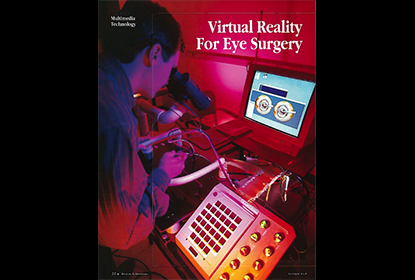
Multimedia Technology Lab led by Mike Sinclair develops a proof of concept virtual reality eye surgery simulator at Georgia Tech in cooperation with the Medical College of Georgia.
1994

Multimedia Technology Research Laboratory develops Motion Interactive (MINT), a software package for creating animated figures that simulate human movement. Pictured left-to-right are Mike Sinclair and student Scott Robertson. This is part of the bio-mechanical research going on at Georgia Tech partly spurred by the Olympics.
1994
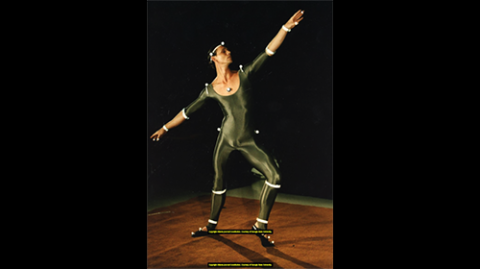
This year marks the start of a 5-year collaboration between the Atlanta Ballet and Georgia Tech. The project's charter is to find innovative ways to integrate technology and the arts, specifically dance. The project's first performance, "Non Sequitur,” featured a ballerina dancing with a computer animated "virtual" dancer and was shown on CNN's Future Watch program in May of 1994. The projects include the use of motion capture technologies.
More info
Partners in projects included Georgia Tech's Robert Ferst Center for the Arts, the Savannah College of Art and Atlanta’s Beacon Dance. Technologies utilized included: 3D motion capture, real-time 3D graphics, bodycams, interactive infra-red sensors, laser sensors, dance pads, real-time visual and audio manipulation, remote data processing and visualization, IR motion tracking of the dancers, and more.
1996 - 1999 Dance Projects

The 1996 Dance Technology Project, choreographed by David Parsons, demonstrated animated dancers and virtual costumes through real-time optical motion tracking and projected animation of costumes onto the dancers.
More info
The 1997 Dance Technology Project featured the use of a graphics super-computer that was made available in the theater through fiber optics telecommunication, about 2 miles away. This performance featured motion tracked balls that were tossed around, causing tumbling 3D objects such as an elephant, house, and space shuttle to appear in place of the balls. A dancer outfitted with a motion tracking system, danced on stage next to her cyber re-embodiment. Possible future developments could include a 3D choreographer's sketchbook, motion capture and visualization for dance analysis and injury prevention, and interactive dance through audience participation. The project was selected to provide a key production for the Cultural Olympiad during the 1996 Olympic Games. On April 29, 1998 was the world premiere of a new dance technology piece titled “Desired”. Created in collaboration with Tech's Interactive Media Technology Center (IMTC), the dance featured choreographer Nicole Livieratos and the GardenHouse Dance Company.
On November 8th, 1999, IMTC in collaboration with The Savannah College of Art and Atlanta’s Beacon Dance, premiered a 45 minute interactive dance performance titled “E-Motion”. The piece focused on the nine movements that are the building blocks of dance - Rise, Collapse, Bend, Stretch, Circle, Twist, Swing, Sway, and Shake. Over 80 students and Faculty at SCAD helped generate ideas and animations based on these terms to link issues of dance and creativity with those of technology and digital culture. IMTC provided integration of the ideas and animations into technology used in the performance. Technologies utilized included: 3D motion capture, real-time 3D graphics, bodycams, interactive infra-red sensors, laser sensors, dance pads, real-time visual and audio manipulation, remote data processing and visualization (Savannah to Atlanta and back), IR motion tracking of the dancers, and more.
1996 - Microsoft DirectMusic

Microsoft DirectMusic, released in 1996, resulted from interactive music work that IMTC collaborated on for the Olympic system. DirectMusic was a component of the Microsoft DirectX API that allows music and sound effects to be composed and played and provides flexible interactive control over the way they are played.
1997 - Perry Historical Museum

IMTC helped support a Sam Nunn project with a historical museum in Perry, Georgia, with new intellectual property (IP) developed for phonetic search of audio archives. Georgia Tech faculty started a company based on the IP called FastTalk. The name was later changed to Nexidia. In 2016, software provider Nice Systems purchased Nexidia for $135 million in cash to expand its growing analytics business.
1997

The High Museum of Art in Atlanta revamped its Visual Arts Learning Space in April, 1997. Four computers with touch-screen capabilities combined with works of art displayed from the High's collection offer interactive learning to visitors to delve deeper into art pieces placed next to each machine . This new interactive experience was developed with High Museum staff and Georgia Tech's Interactive Media Technology Center. The museum's first foray into educational technology, "See for Yourself," is intended to introduce visitors, young and old, to the basic elements of art: line, color, composition and light.
2000
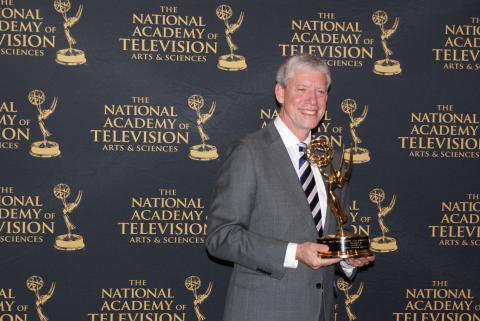
Technology and Engineering Achievement Emmy Award
Fast-Talk Communications, established in 2000, developed the first high-speed audio-voice search engine. It was founded by IMTC/ECE faculty member Mark Clements and his graduate ECE student Peter Cardillo. The company would later be renamed Nexidia, a leading developer of dialogue and audio analysis products and technologies. Many years later In 2016, the company was honored by the National Academy of Television Arts & Sciences (NATAS) with a Technology and Engineering Achievement Emmy Award for Phonetic Indexing and Timing.
2000
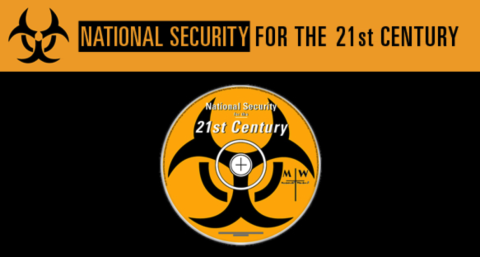
National Security for the 21st Century (CD-ROM) provided an in-depth overview of the national security and domestic terrorism landscape at the beginning of the 21st century. The CD-ROM was developed and co-produced by Library & Information Center and the Interactive Media Technology Center to honor retired Georgia Senator Sam Nunn. It included transcripts and video excerpts from the Annual Sam Nunn Policy Forum, which focused on issues of U.S. national security.
The CD-ROM included interactive multimedia activities and exhibits as well as extensive background documents, interviews with national security experts and discussion questions about the hard choices facing American citizens as they struggle with competing needs such as personal freedom and privacy in an increasingly perilous security landscape. Discussion questions intended to encourage classroom participation at the high school and university level were included. The CD-ROM won the SILVER AXIEM AWARD standard of excellence in interactive multimedia.
2000
Peter Presti with the IMTC develops the haptic lens, a low-cost hardware and software device to enable the real-time visualization of the haptic sense of pressure. The device and supporting PC-based software enabled the visualization and documentation of tactile input for applications such as robotic end-effectors, medical palpation, 3D digitizer, and a novel 3D clay input device for modeling.
2001
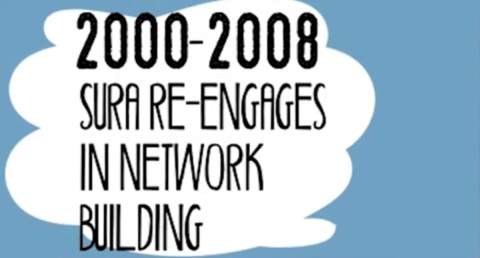
Ed Price, research director in IMTC, takes a leadership role in Sura Net. Here is an overview of Sura Net which included Georgia Tech as a participant.
2001
IMTC faculty develop i‐irasshai, a unique Japanese cultural learning experience for English speaking students delivered through a combination of CD‐ROM and Internet technology. The educational approach taken is a constructivist one, where meaning and knowledge acquisition is rooted in experience. The goal of the program is for students to gain insight into Japanese culture by allowing them to explore Japan within an authentic context, but without the knowledge of a foreign language. Through the integration of photographs, video, and audio captured on location in Japan, students walk through twenty locations including a school, market, temple, shrine, sushi restaurant, and residences. 360‐degree virtual reality images are enhanced with sound and “show me” hot spots that portray modern daily life realistically, much as a visiting student might experience in Japan. Current and historical information is accessible via the immersive environment or through a Guidebook.
2001

Ed Price, research director in IMTC, takes a leadership role in Sura Net. Here is an overview of Sura Net which included Georgia Tech as a participant.
2001
IMTC faculty develop i‐irasshai, a unique Japanese cultural learning experience for English speaking students delivered through a combination of CD‐ROM and Internet technology. The educational approach taken is a constructivist one, where meaning and knowledge acquisition is rooted in experience. The goal of the program is for students to gain insight into Japanese culture by allowing them to explore Japan within an authentic context, but without the knowledge of a foreign language. Through the integration of photographs, video, and audio captured on location in Japan, students walk through twenty locations including a school, market, temple, shrine, sushi restaurant, and residences. 360‐degree virtual reality images are enhanced with sound and “show me” hot spots that portray modern daily life realistically, much as a visiting student might experience in Japan. Current and historical information is accessible via the immersive environment or through a Guidebook.
Interactive Media Technology Center History
The Interactive Media Technology Center (IMTC), now absorbed into IPaT, was a research, design, and education center dedicated to research spanning technology, education, culture, and medicine. IMTC’s focus was in digital media processing, and they applied their research to a wide variety of areas including culture, education, and technology. IMTC played a pivotal role in helping the city of Atlanta win the 1996 Olympic Games. Note that several links on this timeline open a new window to get additional information.
Timeline

(text and background only visible when logged in)
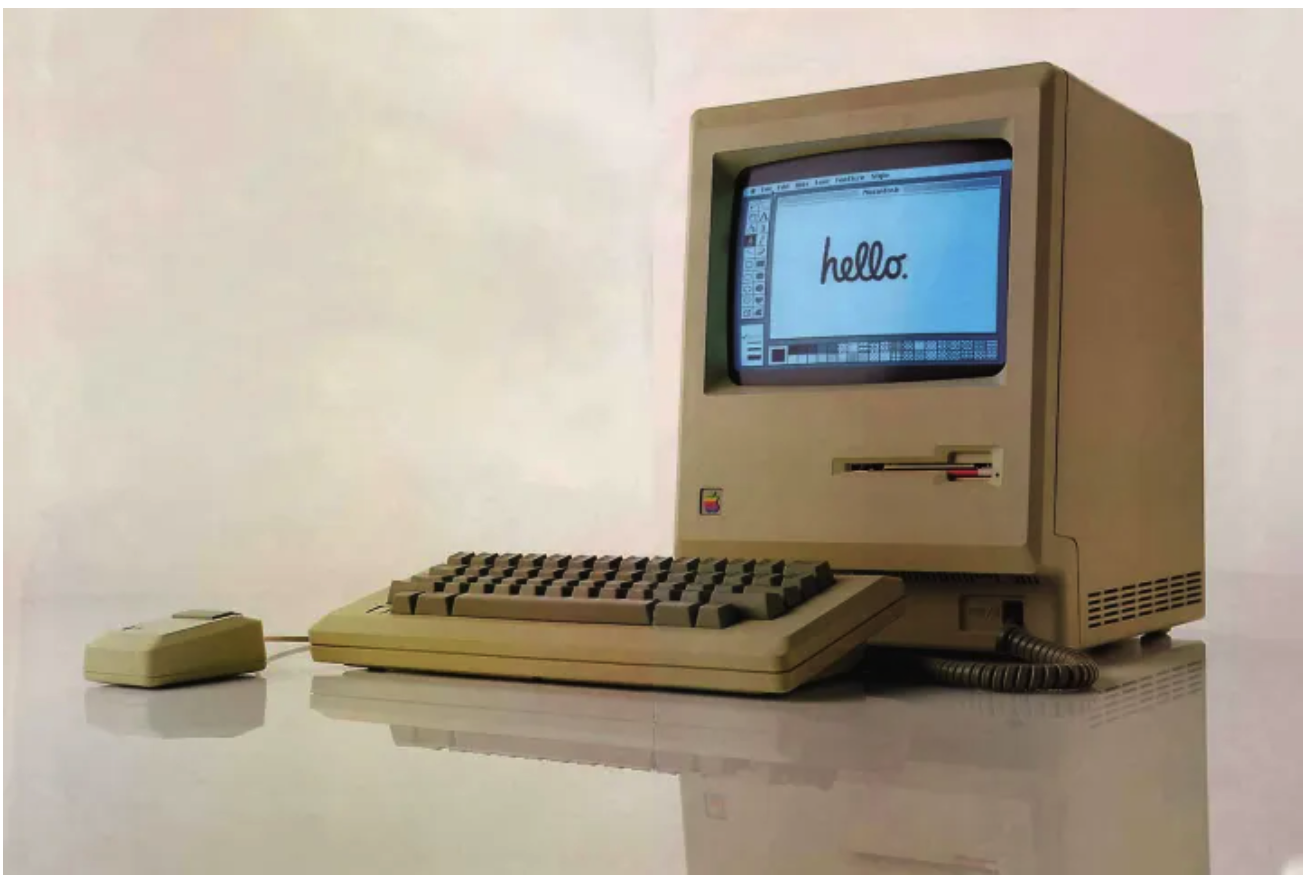

1987
Originally formed as the Multimedia Technology Lab (MmTL) under the Office of Interdisciplinary Programs (OIP) with co-directors Michael Sinclair and Fred Dyer. The initial project was to create a virtual reality system supporting Atlanta's bid for the 1996 Olympics.
More info
OIP executive administrator Jean Gunter provided key support. The lab was located in Centennial Research Building, 3rd floor.
1987 - Bidding for the Olympic Games Starts
The centerpiece of Atlanta's 1996 Summer Olympic bid package was a seven-foot-tall, three-screen interactive video-disc system equipped with touch screen and trackball controls. View picture of the screens. The system was developed by Georgia Tech and GTRI researchers, with assistance from other universities and off-campus organizations. Three interactive presentations were produced by IMTC.
More info
The multimedia presentation combined virtual reality techniques, computer graphics, animation, and aerial photography that allowed viewers to take a virtual airborne tour of proposed Olympic venues. The roots of the Olympic interactive video system could be traced to earlier military projects, including missile defense modeling and simulation research.
August 27, 1989
Olympic System 1 - Magic Carpet Ride
IMTC's first project was to develop an interactive tour of Atlanta and its planned Olympic venues. It allowed International Olympic Committee (IOC) members to fly around the city from the comfort of a hotel suite using a graphics computer and a wooden encased trackball.
More info
The system was unveiled at Atlanta's official entry into the Olympic bid race in San Juan, Puerto Rico, in September, 1989. A map screen showed where the user was in the city, and icons for each Olympic sport. The user could "fly" into icons representing the sports venues, and the video screen would descend to earth and enter the facility. The system served as a "virtual" bid book, as each voting member could easily and quickly, and interactively look up information pertinent to their questions. The system spent the year after its premier traveling the world to wherever voting IOC delegates met to help sell Atlanta to the world.
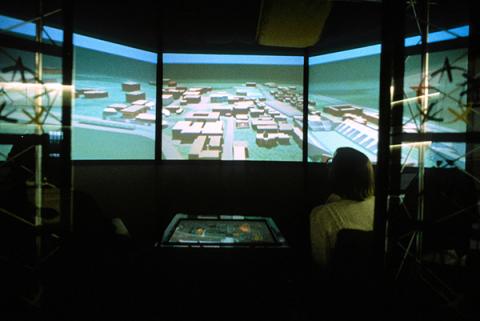
1990
Olympic System 2 - Vision of the Village
Tech's second Olympic system took an up close and personal look at plans for Atlanta's Olympics. Many of the facilities, such as the Olympic Village, were shown in a high-tech theater using a surround interactive video system developed by Tech.
More info
IMTC and the Atlanta Organizing Committee decided that Atlanta needed another high-tech sales tool for the final vote for the Centennial games, scheduled for Tokyo, in September, 1990. The system was unveiled in the final days of the Olympic bidding in Tokyo in 1990. Both Olympic systems were a collaboration of a number of campus and industrial collaborators.
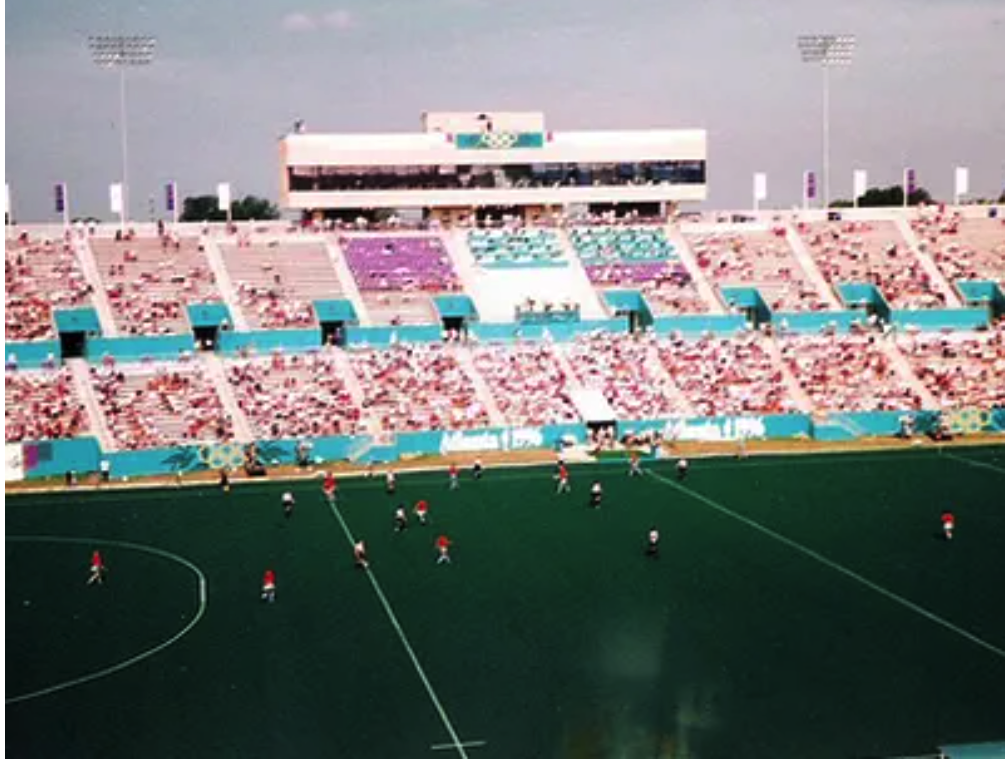
1990 - 1996
Olympic System 3 - Vision of Atlanta
The final version of the system was upgraded to contain information on all of Georgia's Olympic sites and widely shown for many years. This system presented panoramic views of Atlanta and the state of Georgia, with an opportunity to move through panoramas and select venues for more information. This system became part of the Georgia Resource Center, an economic development facility for Georgia.
More info
This iteration of the system featured an animated map of the Georgia Tech campus back-projected onto a frosted Lucite model. This served as a sort of touch screen controller. Touching points on the Lucite map would drive the location viewed on the screens. This huge feat wasn’t accomplished in a silo. Team members' recall how willing businesses and organizations were to pitch in. For example, Delta Airline’s machine shop assisted with the Lucite model. People from Georgia State wrote the scripts and managed production of video for the final presentation that was delivered to the International Olympic Committee in Tokyo in 1990. One example in this version was the full-color computer-simulated "fly-through" of the Olympic whitewater events venue. It was designed to orient TV viewers whenever Olympics coverage shifted from Atlanta-area sports venues to the whitewater course in Tennessee. GTRI developers integrated data from the LANDSAT satellite, high-altitude and low-altitude photography, and U.S. Geological Survey elevation information into the simulation.
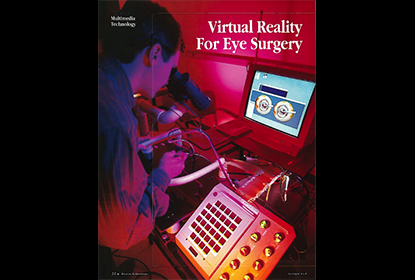
1993
Multimedia Technology Lab led by Mike Sinclair develops a proof of concept virtual reality eye surgery simulator at Georgia Tech in cooperation with the Medical College of Georgia.

1994
Multimedia Technology Research Laboratory develops Motion Interactive (MINT), a software package for creating animated figures that simulate human movement. Pictured left-to-right are Mike Sinclair and student Scott Robertson. This is part of the bio-mechanical research going on at Georgia Tech partly spurred by the Olympics.
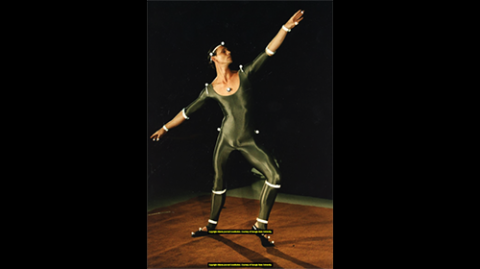
1994
This year marks the start of a 5-year collaboration between the Atlanta Ballet and Georgia Tech. The project's charter is to find innovative ways to integrate technology and the arts, specifically dance. The project's first performance, "Non Sequitur,” featured a ballerina dancing with a computer animated "virtual" dancer and was shown on CNN's Future Watch program in May of 1994. The projects include the use of motion capture technologies.
More info
Partners in projects included Georgia Tech's Robert Ferst Center for the Arts, the Savannah College of Art and Atlanta’s Beacon Dance. Technologies utilized included: 3D motion capture, real-time 3D graphics, bodycams, interactive infra-red sensors, laser sensors, dance pads, real-time visual and audio manipulation, remote data processing and visualization, IR motion tracking of the dancers, and more.
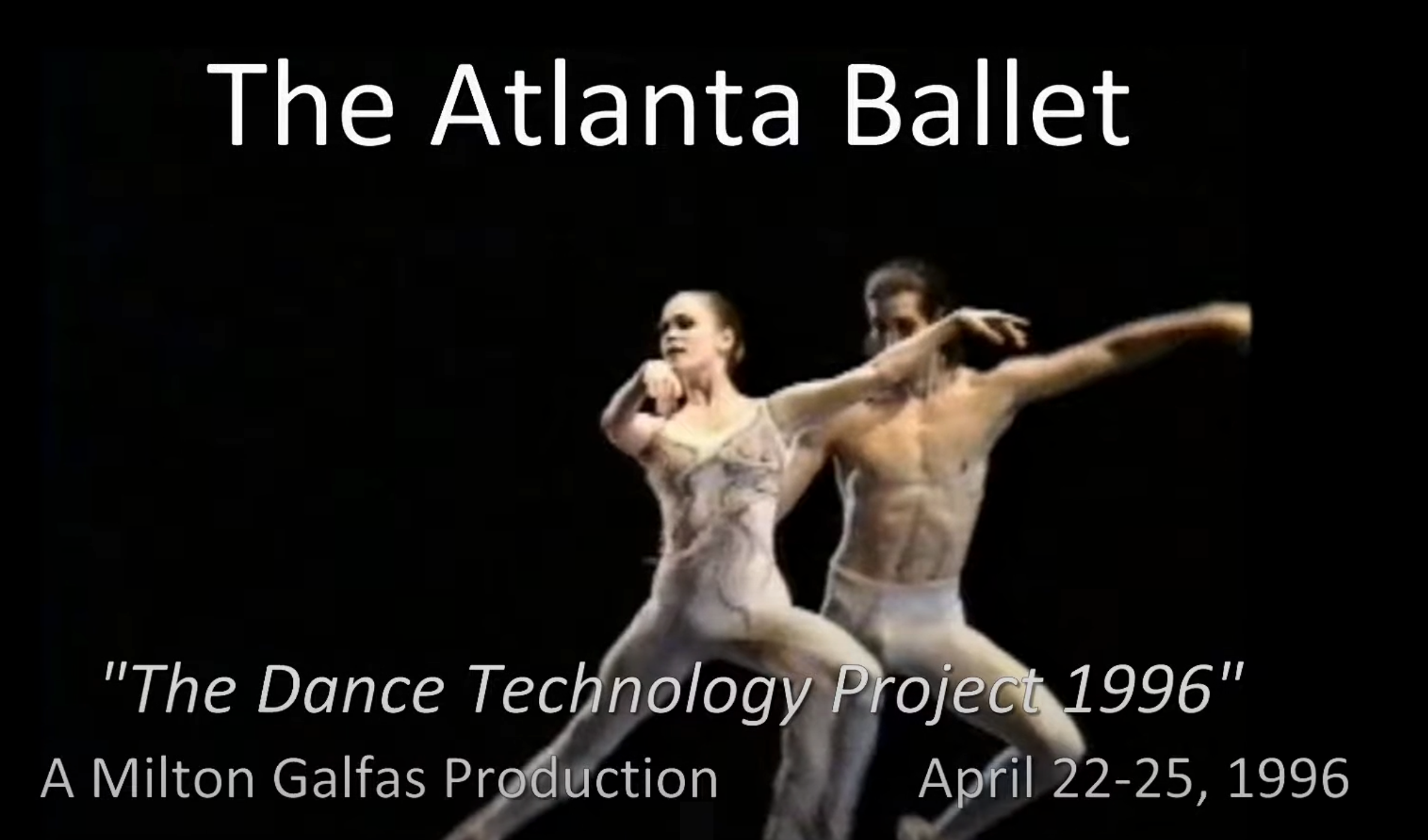
1996 - 1999 Dance Projects
The 1996 Dance Technology Project, choreographed by David Parsons, demonstrated animated dancers and virtual costumes through real-time optical motion tracking and projected animation of costumes onto the dancers.
More info
The 1997 Dance Technology Project featured the use of a graphics super-computer that was made available in the theater through fiber optics telecommunication, about 2 miles away. This performance featured motion tracked balls that were tossed around, causing tumbling 3D objects such as an elephant, house, and space shuttle to appear in place of the balls. A dancer outfitted with a motion tracking system, danced on stage next to her cyber re-embodiment. Possible future developments could include a 3D choreographer's sketchbook, motion capture and visualization for dance analysis and injury prevention, and interactive dance through audience participation. The project was selected to provide a key production for the Cultural Olympiad during the 1996 Olympic Games. On April 29, 1998 was the world premiere of a new dance technology piece titled “Desired”. Created in collaboration with Tech's Interactive Media Technology Center (IMTC), the dance featured choreographer Nicole Livieratos and the GardenHouse Dance Company.
On November 8th, 1999, IMTC in collaboration with The Savannah College of Art and Atlanta’s Beacon Dance, premiered a 45 minute interactive dance performance titled “E-Motion”. The piece focused on the nine movements that are the building blocks of dance - Rise, Collapse, Bend, Stretch, Circle, Twist, Swing, Sway, and Shake. Over 80 students and Faculty at SCAD helped generate ideas and animations based on these terms to link issues of dance and creativity with those of technology and digital culture. IMTC provided integration of the ideas and animations into technology used in the performance. Technologies utilized included: 3D motion capture, real-time 3D graphics, bodycams, interactive infra-red sensors, laser sensors, dance pads, real-time visual and audio manipulation, remote data processing and visualization (Savannah to Atlanta and back), IR motion tracking of the dancers, and more.
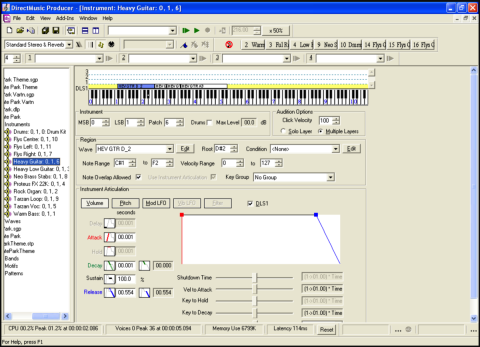
1996 - Microsoft DirectMusic
Microsoft DirectMusic, released in 1996, resulted from interactive music work that IMTC collaborated on for the Olympic system. DirectMusic was a component of the Microsoft DirectX API that allows music and sound effects to be composed and played and provides flexible interactive control over the way they are played.
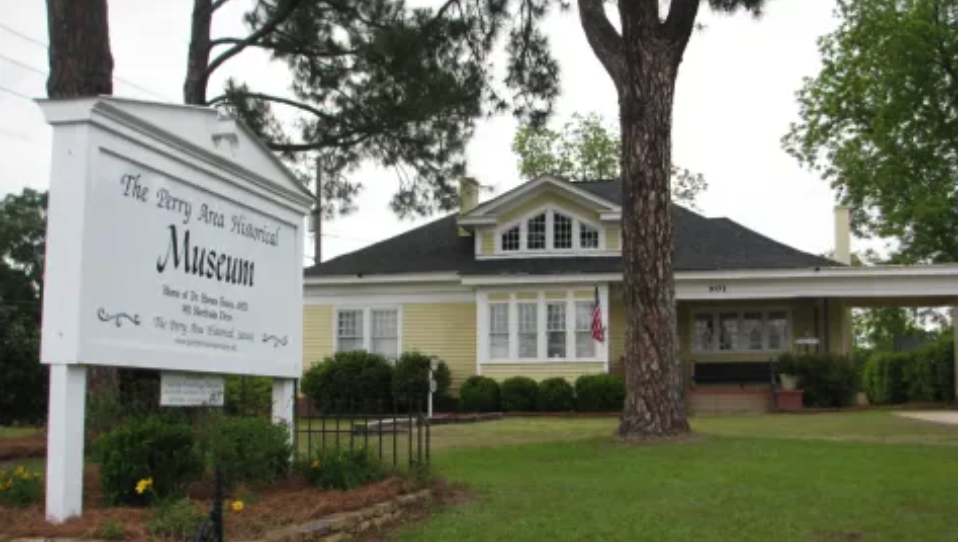
1997 - Perry Historical Museum
IMTC helped support a Sam Nunn project with a historical museum in Perry, Georgia, with new intellectual property (IP) developed for phonetic search of audio archives. Georgia Tech faculty started a company based on the IP called FastTalk. The name was later changed to Nexidia. In 2016, software provider Nice Systems purchased Nexidia for $135 million in cash to expand its growing analytics business.
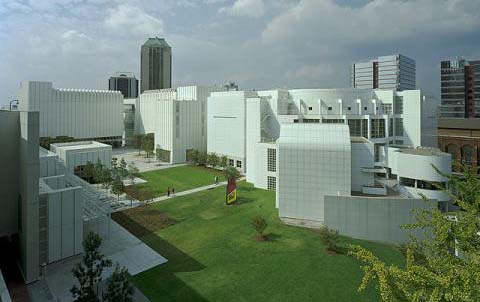
1997
The High Museum of Art in Atlanta revamped its Visual Arts Learning Space in April, 1997. Four computers with touch-screen capabilities combined with works of art displayed from the High's collection offer interactive learning to visitors to delve deeper into art pieces placed next to each machine . This new interactive experience was developed with High Museum staff and Georgia Tech's Interactive Media Technology Center. The museum's first foray into educational technology, "See for Yourself," is intended to introduce visitors, young and old, to the basic elements of art: line, color, composition and light.
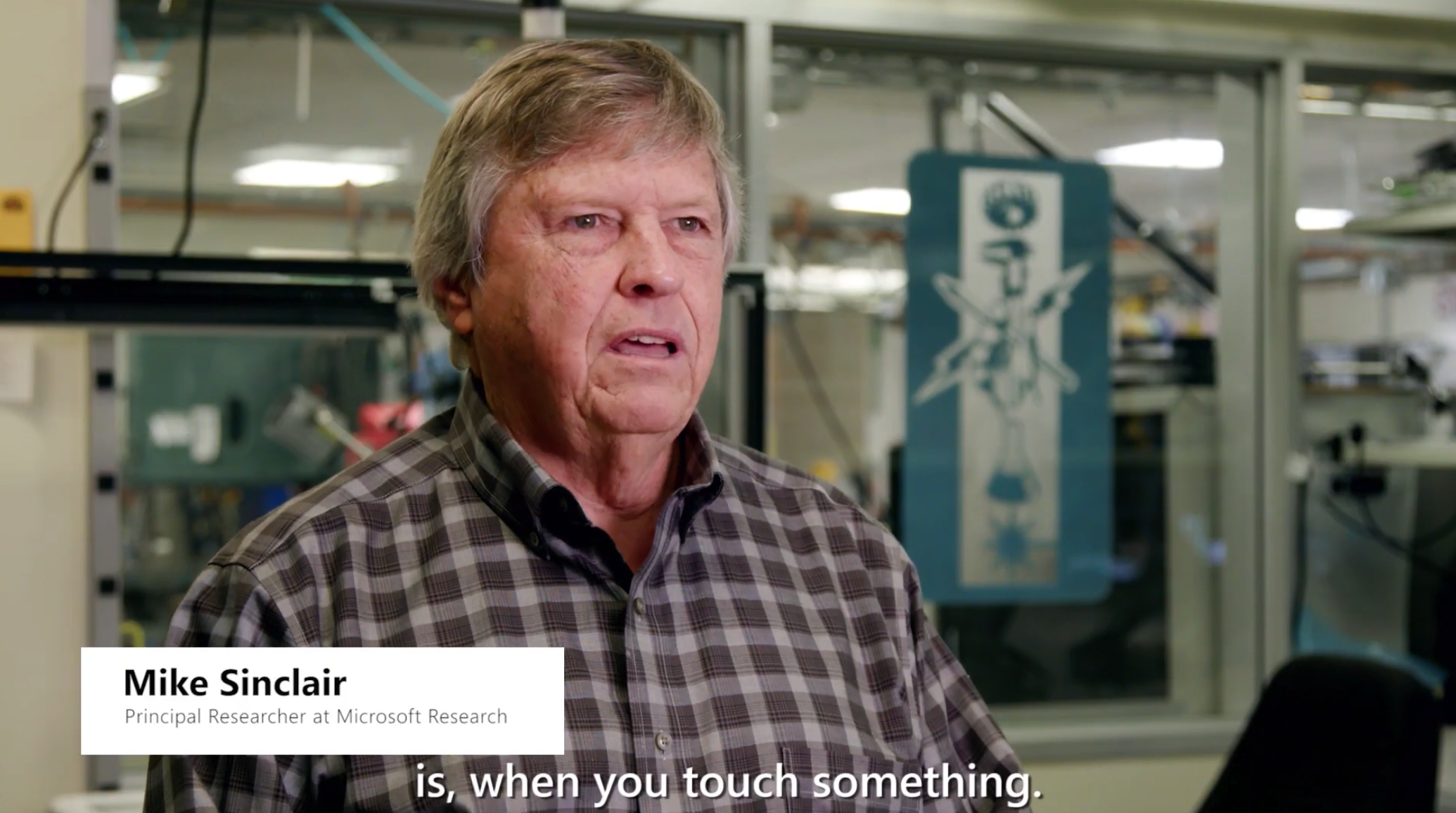
1997
Mike Sinclair and Peter Presti, both with the IMTC, develop the haptic lens, a low-cost hardware and software device to enable the real-time visualization of the haptic sense of pressure. The device and supporting PC-based software enabled the visualization and documentation of tactile input for applications such as robotic end-effectors, medical palpation, 3D digitizer, and a novel 3D clay input device for modeling. Sinclair would later join Microsoft in haptic development in 1998.
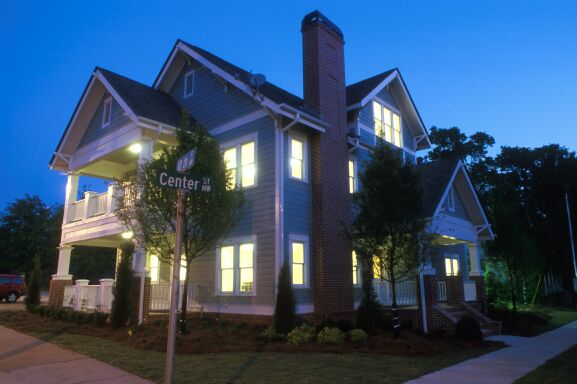
1998
The Broadband Institute's Residential Laboratory at Georgia Tech has been constructed to allow researchers to develop and evaluate technologies for the homes of the future in a real-life setting. One focus of research in the house is the Aware Home Research Initiative. The goal of this work is to sense, recognize, and interpret the activity of those living in the house, thus creating a home that is aware of its occupants. This awareness results in a living area that can assist the human residents, can anticipate their needs, and can improve the quality of their lives. IMTC has been working with faculty and students from the Future Computing Environments group to explore various research projects pertaining to home automation and contextual awareness. Initial funding for the building of the Residential Laboratory was provided by the Georgia Research Alliance (GRA).
For a general overview of the Aware Home project, see "Sensing the Subtleties of Everyday Life" an article that appeared in the Winter 2000 issue of Research Horizons (by Jane M. Sanders), the research magazine of Georgia Tech.

2000
Technology and Engineering Achievement Emmy Award
Fast-Talk Communications, established in 2000, developed the first high-speed audio-voice search engine. It was founded by IMTC/ECE faculty member Mark Clements and his graduate ECE student Peter Cardillo. The company would later be renamed Nexidia, a leading developer of dialogue and audio analysis products and technologies. Many years later In 2016, the company was honored by the National Academy of Television Arts & Sciences (NATAS) with a Technology and Engineering Achievement Emmy Award for Phonetic Indexing and Timing.

2000
National Security for the 21st Century (CD-ROM) provided an in-depth overview of the national security and domestic terrorism landscape at the beginning of the 21st century. The CD-ROM was developed and co-produced by Library & Information Center and the Interactive Media Technology Center to honor retired Georgia Senator Sam Nunn. It included transcripts and video excerpts from the Annual Sam Nunn Policy Forum, which focused on issues of U.S. national security.
The CD-ROM included interactive multimedia activities and exhibits as well as extensive background documents, interviews with national security experts and discussion questions about the hard choices facing American citizens as they struggle with competing needs such as personal freedom and privacy in an increasingly perilous security landscape. Discussion questions intended to encourage classroom participation at the high school and university level were included. The CD-ROM won the SILVER AXIEM AWARD standard of excellence in interactive multimedia.

October 2000
The Beware Home
During most of the year the faculty, researchers, and students that make up the Aware Home Research Initiative spend their time developing technologies to create a home environment that can both perceive and assist its occupants. However, for Halloween 2000, the Aware Home was transformed into the “Beware Home.” IMTC, the College of Computing, and the School of Industrial Design collaborated to produce a haunted tour of the Broadband Residential Laboratory that showcased many of their current research projects. The goal was to show off real projects, but in a fun and scary way.
For the story line, a resident of the “Beware Home,” Granny, has been mysteriously murdered. Guests to the house were asked to explore the exhibits and figure out who had perpetrated this crime. Before entering the house, visitors were presented with a wearable device that would play audio based on their position inside the house. This system, WestWind, served as a tour guide to explain the demos and to reveal the storyline.
More info
Inside the house, visitors experienced an environment decorated with typical haunted house regalia, as well as “magic” glasses that allowed them to see Bloodell wreaking havoc in the kitchen. Meanwhile the kitchen cabinets opened and closed on their own and items on the counter danced around. This was a demonstration of an augmented reality system that used a head-mounted display to overlay video of the “ghost” on the real kitchen.
The Digital Family Portrait, which usually shows an ambient display on how active a remote family member has been, instead had gone crazy and showed skeletal and decaying pictures of grandma. In the study, guests were told to write on the wall with a mystical device (a laser pointer). The movement of the pointer on the wall was tracked by a video projection, so that it looked as though the pointer was leaving a burning trail. The visitors were asked to write magical symbols to enact a spell (gesture recognition was used to determine what symbols were written). Based on which symbol was drawn, they would either be sent to hell or a visit from Bloodell who would explain why he committed the murders.
In the child’s room, guests were greeted by a disembodied baby head with glowing red eyes. If the guest squeaked or rattled one of the child’s toys, the head would turn toward the source of the sound. This was accomplished via a microphone array used for pinpointing sound sources in 3D.
Lastly, guests would enter the master bedroom, the site of the murder. The room appeared empty, but when a “magic” flashlight (which was only outputting light in the IR range) was shone on the wall, images of grandma and the ghost were revealed.
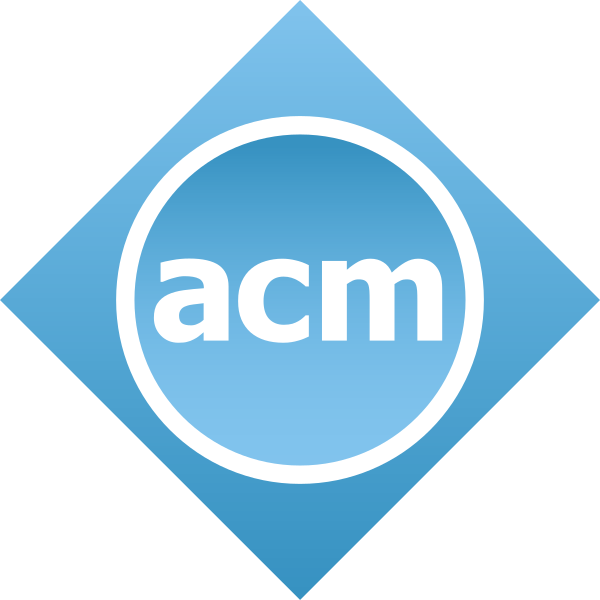
2001
In March of 2001, the College of Computing’s Aware Research Initiative was invited to produce a display for the ACM1 2001 exhibition in San Jose, CA. The goal of this exhibition was to highlight technologies of the future, such as technologies for the home. IMTC, the School of Industrial Design, and the College of Computing teamed up to create a small version of the Residential Laboratory on the exhibit floor. Visitors could wander through a mock bedroom, bathroom, living room, and kitchen. In the bedroom, they could see how a distant loved-one was doing with the Digital Family Portrait or talk to researchers in Atlanta via the Family Intercom. With the Gesture Pendant, the wave of their hand could control numerous devices in the house such as the television, stereo, and lamp. In the bathroom, visitors could find out about the Online Medicine Cabinet (an Accenture project) or experiment with a new type of storytelling in the living room with the Listen Reader (a Xerox Parc project). In the kitchen, the What Was I Cooking project helped users recover from interruptions that can occur while cooking.
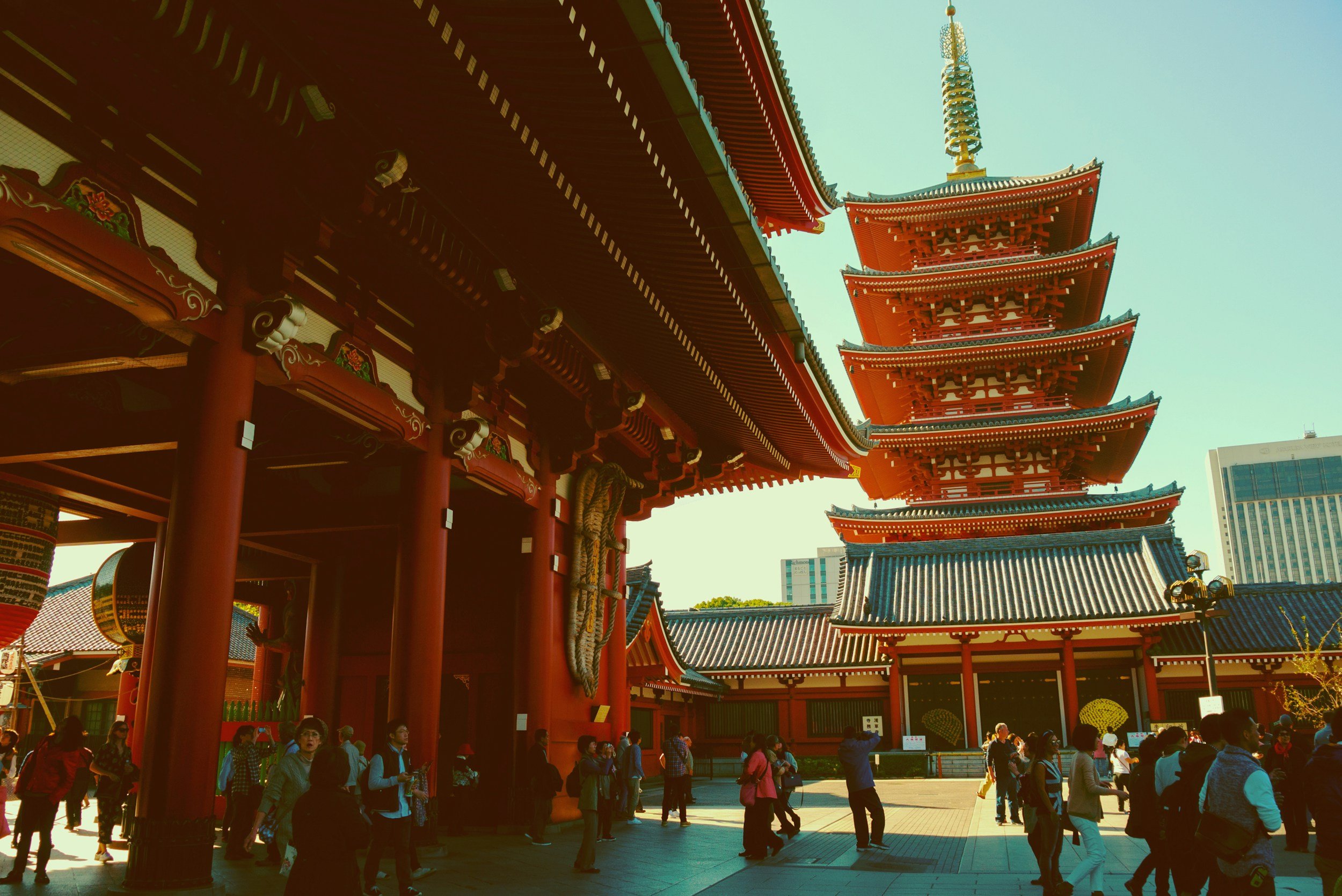
2001
IMTC faculty develop i‐irasshai, a unique Japanese cultural learning experience for English speaking students delivered through a combination of CD‐ROM and Internet technology. The educational approach taken is a constructivist one, where meaning and knowledge acquisition is rooted in experience. The goal of the program is for students to gain insight into Japanese culture by allowing them to explore Japan within an authentic context, but without the knowledge of a foreign language. Through the integration of photographs, video, and audio captured on location in Japan, students walk through twenty locations including a school, market, temple, shrine, sushi restaurant, and residences. 360‐degree virtual reality images are enhanced with sound and “show me” hot spots that portray modern daily life realistically, much as a visiting student might experience in Japan. Current and historical information is accessible via the immersive environment or through a Guidebook.

2002
The Rehabilitation Engineering Research Center (RERC) is formed. The program's goals are to ensure access to mobile wireless products and services by people of all ages and abilities, and investigate applications of mobile wireless technologies that promote independent living and community integration. The collaborating institutions included Georgia Tech, Georgia Centers for Advanced Telecommunications Technology, and the Shepard Center.

2002
Ed Price, research director in IMTC, takes a leadership role in Sura Net. Here is an overview of Sura Net which included Georgia Tech as a participant.

2007
The Philanthropy Gallery in The Millennium Gate and Museum at Atlantic Station is a grand interactive experience in which patrons of all ages can discover the vital role philanthropy has played in shaping Atlanta over the years. Developed by the Interactive Media Technology Center (IMTC) at Georgia Tech, the exhibit blends super-high-definition imagery with 3D graphics to allow visitors to explore how philanthropy has transformed Atlanta from a sleepy Southern city to the gateway of the world. The interaction was crafted such that the exhibit can be used effectively by a single person or a large school group, with up to three interacting with the program simultaneously.
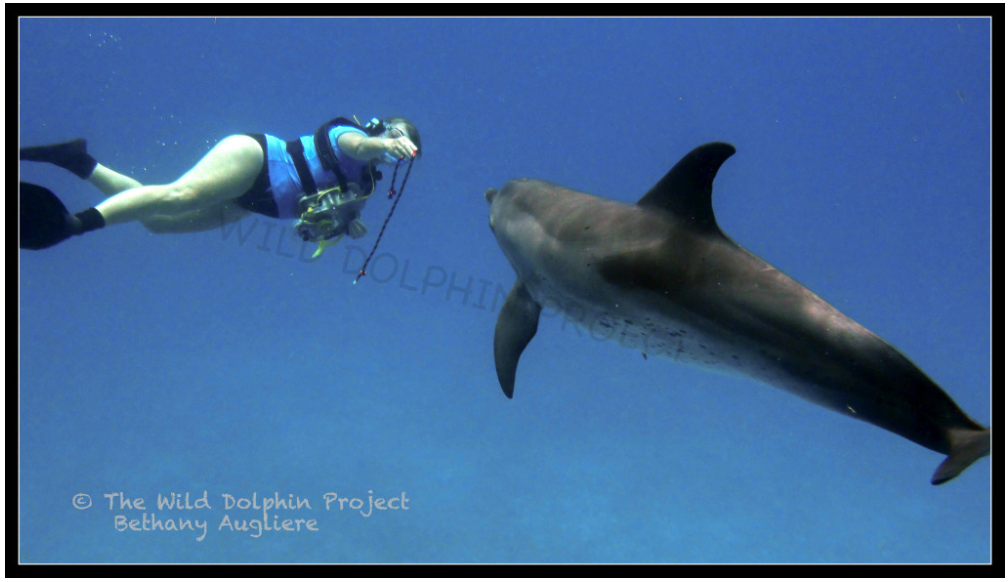
2010
The Dolphin Project joins forces with Georgia Tech in Atlanta to develop a state-of-the-art technology specifically designed for two way communication with dolphins. Dr. Thad Starner at Georgia Tech and his students started creating a high-tech, dolphin- and human-friendly diver system to restart the exploration of a new interface in the wild. In addition, pattern recognition software is being developed to help categorize and decode the dolphins' natural sounds. This project is still active in 2025 and starts to integrate AI into the project.




